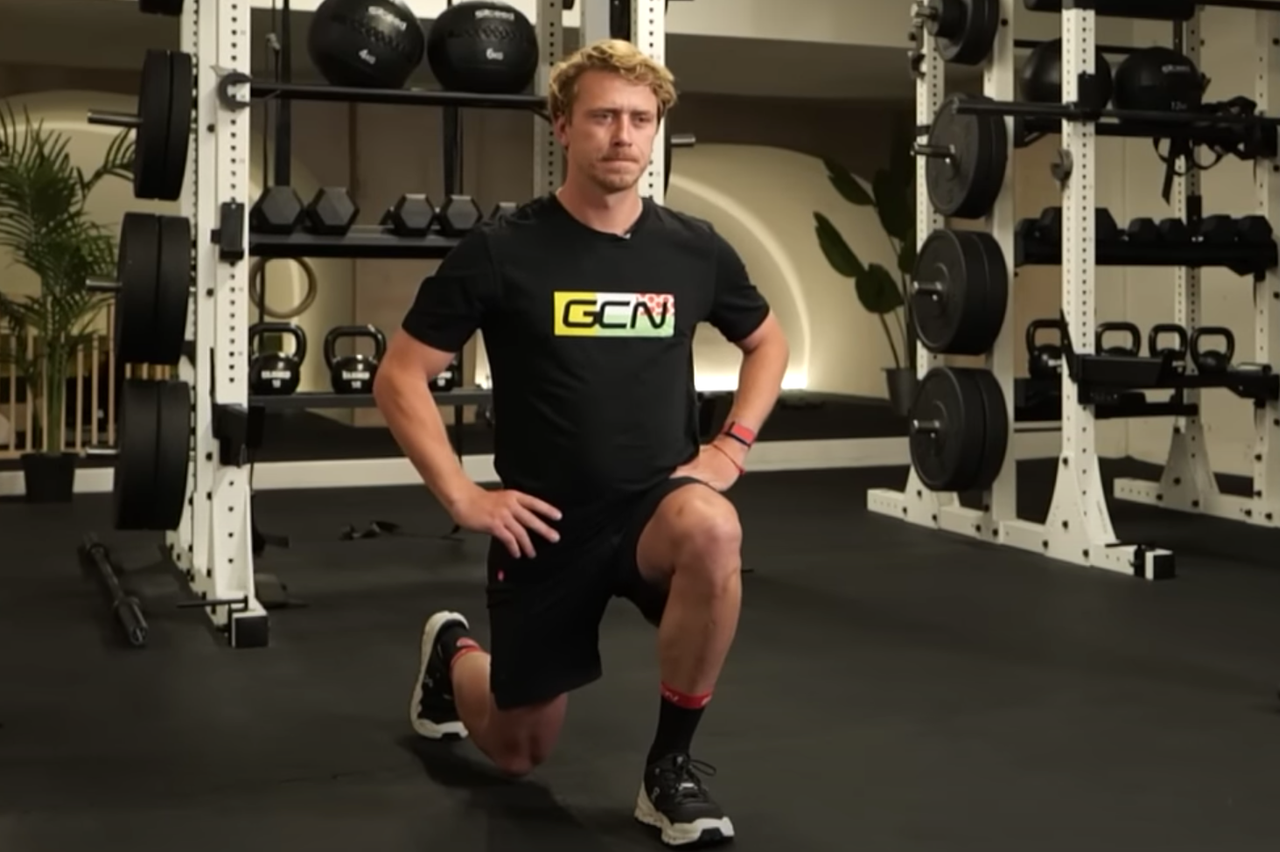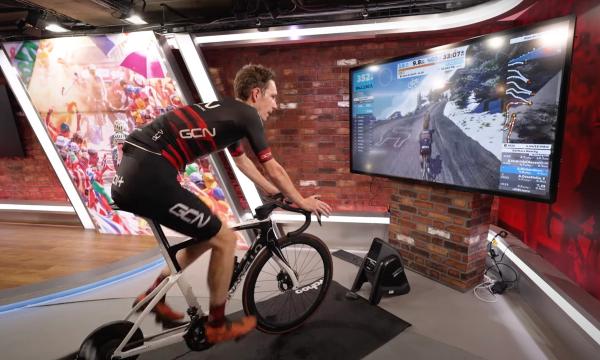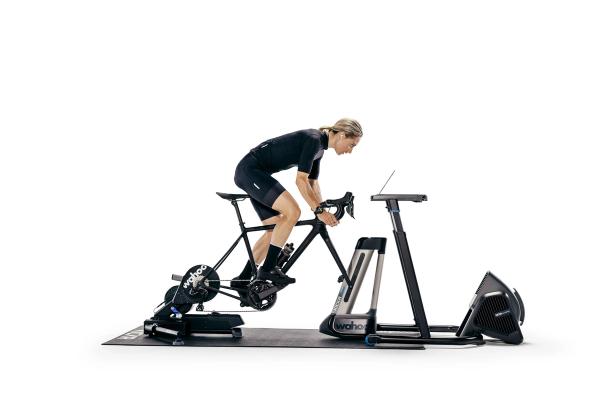How to incorporate strength training into an indoor cycling plan
As much as most cyclists want to avoid it, strength training can have big benefits
Tom Hallam-Gravells
Online Production Editor
© GCN
Strength training has plenty of benefits for cyclists
Strength training: it’s a phrase that strikes fear into most cyclists, enough to make weedy legs and arms tremble before a weight or squat has even been attempted. That’s completely understandable, since most cyclists aren’t built for strength. Endurance is our thing.
Unfortunately, as much as most cyclists would like to avoid it, strength workouts can have big benefits. That’s why they should be integrated into any training plan and there’s no better time to do it than turbo training season, when you’re setting the fitness foundations for the next year.
Here’s how to successfully integrate strength training into a turbo training plan and how you can build strength through on-bike exercises.
- Read more: GCN's ultimate guide to indoor cycling
Benefits of strength training for cycling
Aversion to strength training is rife among cyclists, so we know many of you will take some convincing. Unfortunately for those who want to avoid it, strength workouts have lots of proven benefits.
Better on-bike performance

© GCN
Strength training could help you push out more watts
The most obvious benefit is improved leg strength, which leads to more power on the bike. Many studies also point to other significant benefits too.
In a study published in 2009, B. R. Rønnestad, E. A. Hansen and T. Raastad tested the effects of strength training on endurance cyclists. One group stuck to their regular endurance training, while another group incorporated two strength workouts per week into their routine. By the end of the 12-week period, the second group displayed reduced “oxygen consumption, heart rate, blood lactate concentration, and rate of perceived exertion during the last hour of the prolonged cycling”.
So, the benefits could go far beyond being able to put out more watts.
Correct muscle imbalances
In terms of recruiting different muscle groups, cycling is a limited sport. Most of the strain is put through the calves and quads. That can lead to muscle imbalances in other areas like the hamstrings, glutes and hip flexors, which are often left trailing behind.
Strength training is a great way to address these muscle imbalances. As an added bonus, it can also make you more efficient at recruiting underused muscle groups like the glutes and hamstrings, which are generally not efficiently used while cycling.
Prevent injuries
Correcting muscle imbalances won’t just improve efficiency, it can also prevent injuries.
As mentioned, cycling only recruits certain parts of the body. Other parts can become weakened which could lead to injuries. By strengthening these areas, you can stave off any potential injuries.
Core strength = improved pedalling efficiency

© GCN
Strength training can improve pedalling efficiency
Sticking to the theme of avoiding injuries, many cyclists suffer with wear and tear issues, like back pain or sore wrists.
These problems are often caused by bad posture on the bike, which in turn is linked to poor core strength. Along with weedy arms, cyclists also aren’t known for their strong cores, but neglecting this area of your body can cause problems. By strengthening your core, you can improve your posture on the bike, which will in turn lead to better pedalling efficiency too, which is often one of the first victims when fatigue kicks in.
How to add strength workouts to your cycling training plan
Okay, you’re hopefully now convinced by the benefits of strength training, but how do you actually incorporate it into a plan that includes both cycling outdoors on your road bike and indoor cycling on the smart trainer? Here are a few tips.
Don’t overload yourself on strength training
The aim isn’t to become a bodybuilder, so you don’t need to be doing strength training every day. You also don’t want it to impact the most important part of your training plan, the cycling.
So, only add a couple of sessions per week. Try to plan them for non-cycling days, although they can also be completed on days when you’ve also got a cycling session.
Keep your workout sessions short
Whenever you recruit new muscle groups that have laid inactive, there’s going to be lots of soreness. This will only be compounded if you over train.
That’s why it’s best to keep any strength training sessions short, especially to begin with. The length and intensity can be increased as your capacity for strength training increases. Luckily, as your body gets used to it, the aches should dissipate, although they probably won’t totally disappear.

© GCN
Don't overtrain as this will causes a lot of soreness and potentially injuries
Listen to your body
Always listen to your body. This is true of any type of training. If you feel particularly achey, give the session a miss. You also shouldn’t be completely wiped out after a workout, although your muscles will be sore. If you’re struggling to get on the bike the next day, it’s a sign that you need to lower the intensity.
Be consistent with your training programme
Things will be much easier if you’re consistent, something that is true of any type of training. By keeping up with workouts, you’ll ensure maximum gains.
Use a cycling fitness app
Getting started can be daunting, so why not use a cycling training app? Many training apps like Wahoo SYSTM have strength training workouts built in. Even better, Wahoo’s platform can add workouts into your training plan for you. All you have to do is turn up and complete them.

© GCN
Wahoo SYSTM includes strength training workouts
Best strength workouts for cyclists
Need some strength training inspiration? We’ve put our presenters through plenty of strength-training suffering in the past, all for your benefit. Most recently, James ‘Hank’ Lowsley-Williams tested six beginner strength training exercises.
On-bike strength training
Let’s be honest, it’s often hard to squeeze a ride in amongst the chaos of everyday life. If you’re a time-crunched cyclist, you probably won’t have much spare time to cram any strength training in.
Don’t worry! While off-bike training is preferable wherever possible, there are some on-bike strength exercises that you can complete too. These won’t target as many muscle groups, so won’t lead to all of the benefits outlined above, but can improve strength and performance on the bike. Here’s a couple of ways to introduce strength training into rides.
Over-geared efforts
The most obvious way to do this is through over-geared efforts. Most cyclists have a comfortable cadence (pedal revolutions per minute), usually above 80RPM.
An over-geared effort involves riding at a tougher than usual gear at a lower RPM. This will put extra stress on the muscles, causing some serious leg burn.
This is easy to do on a turbo trainer, especially if you use ERG mode.
Riding in and out of the saddle
This one can be completed indoors, but if you don’t like riding out of the saddle on a turbo trainer, save it for outdoors.
When riding at the limit, some riders prefer to stay planted in the saddle while others like dancing on the pedals.
Once again, if you have a leaning towards one riding position, it means that you could be limiting the number of muscles you’re recruiting. To correct this, spend time in both positions during rides, spending time both in and out of the saddle. This will help strengthen muscles you may not usually recruit.
Do you complete strength workouts? Let us know in the comments.
Need more indoor cycling help or inspiration? GCN's ultimate guide to indoor cycling has you covered with advice and guides on everything from turbo training tech to workouts. Check it out here.

.jpg?rect=957,780,3097,3060&w=600&auto=format)







.jpg?w=600&auto=format)


